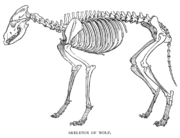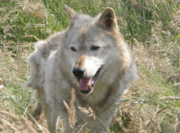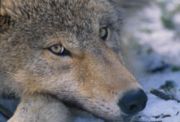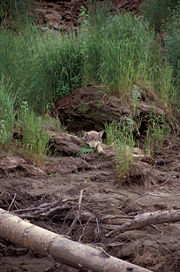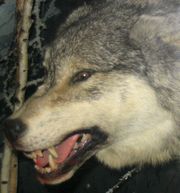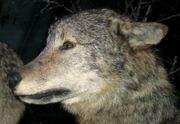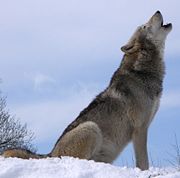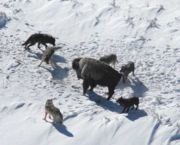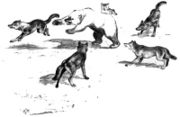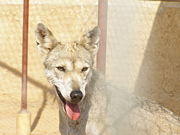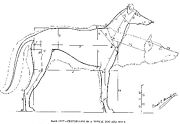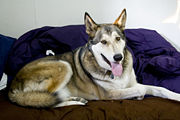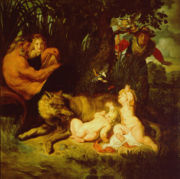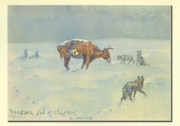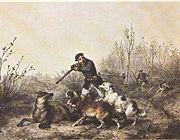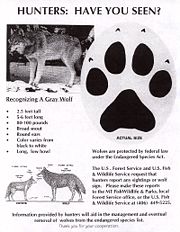Gray Wolf
2008/9 Schools Wikipedia Selection. Related subjects: Mammals
| Gray Wolf Fossil range: Late Pleistocene - Recent |
||||||||||||||
|---|---|---|---|---|---|---|---|---|---|---|---|---|---|---|
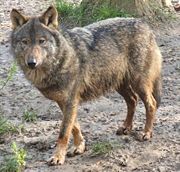 Iberian Wolf (Canis lupus signatus)
|
||||||||||||||
| Conservation status | ||||||||||||||
| Scientific classification | ||||||||||||||
|
||||||||||||||
| Binomial name | ||||||||||||||
| Canis lupus Linnaeus, 1758 |
The gray wolf or grey wolf (Canis lupus), also known as the timber wolf or wolf, is a mammal of the order Carnivora. The gray wolf is the largest wild member of the Canidae family and an ice age survivor originating during the Late Pleistocene around 300,000 years ago. DNA sequencing and genetic drift studies indicate that the gray wolf shares a common ancestry with the domestic dog, (Canis lupus familiaris) and might be its ancestor. A number of other gray wolf subspecies have been identified, though the actual number of subspecies is still open to discussion. Gray wolves are typically apex predators in the ecosystems they occupy. Gray wolves are highly adaptable and have thrived in temperate forests, deserts, mountains, tundra, taiga, grasslands and urban areas.
Though once abundant over much of North America and Eurasia, the gray wolf inhabits a very small portion of its former range because of widespread destruction of its habitat, human encroachment of its habitat, and the resulting human-wolf encounters that sparked broad extirpation. Considered as a whole, however, the gray wolf is regarded as being of least concern for extinction according to the International Union for the Conservation of Nature and Natural Resources. Today, wolves are protected in some areas, hunted for sport in others, or may be subject to extermination as perceived threats to livestock and pets.
In areas where human cultures and wolves are sympatric, wolves frequently feature in the folklore and mythology of those cultures, both positively and negatively.
Physiology
Physical characteristics
Wolf weight and size can vary greatly worldwide, tending to increase proportionally with latitude as predicted by Bergmann's Rule. In general, height varies from 0.6 to .95 meters (26–38 inches) at the shoulder and weight ranges from 20 (44 lb.) up to 68 (150 lb.) kilograms, which together make the gray wolf the largest of all wild canids. Although rarely encountered, extreme specimens of more than 77 kg (170 lb.) have been recorded in Alaska, Canada and Russia. The heaviest recorded wild wolf in the New World was killed on 70 Mile River in east central Alaska on July 12, 1939 and weighed 79 kg (175 lb.), while the heaviest recorded wild wolf in the Old World was killed after WWII in the kobelyakski Area of the Poltavskij Region in the Russian SFSR and weighed 86 kg (189 lb.). The smallest wolves come from the Arabian Wolf subspecies, the females of which may weigh as little as 10 kg (22 lb) at maturity. Wolves are sexually dimorphic, with females in any given wolf population typically weighing 20% less than males. They also have narrower muzzles and foreheads, slightly shorter, smoother furred legs and less massive shoulders. Wolves can measure anywhere from 1.3 to 2 meters (4.5–6.5 feet) from nose to the tip of the tail, which itself accounts for approximately one quarter of overall body length.
Wolves are built for stamina, possessing features ideal for long-distance travel. Their narrow chests and powerful backs and legs facilitate efficient locomotion. They are capable of covering several miles trotting at about a pace of 10 km/h (6 mph), and have been known to reach speeds approaching 65 km/h (40 mph) during a chase. One female wolf was recorded to have made 7 metre bounds when chasing prey.
Wolf paws are able to tread easily on a wide variety of terrains, especially snow. There is a slight webbing between each toe, which allows them to move over snow more easily than comparatively hampered prey. Wolves are digitigrade, which, with the relative largeness of their feet, helps them to distribute their weight well on snowy surfaces. The front paws are larger than the hind paws, and have a fifth digit, the dewclaw, that is absent on hind paws. Bristled hairs and blunt claws enhance grip on slippery surfaces, and special blood vessels keep paw pads from freezing. Scent glands located between a wolf's toes leave trace chemical markers behind, helping the wolf to effectively navigate over large expanses while concurrently keeping others informed of its whereabouts. Unlike dogs and coyotes, wolves lack sweat glands on their paw pads. This trait is also present in Eastern Canadian Coyotes which have been shown to have recent wolf ancestry. Wolves in Israel are unique due to the middle two toes of their paws being fused, a trait originally thought to be unique to the African Wild Dog.
Wolves have bulky coats consisting of two layers. The first layer is made up of tough guard hairs that repel water and dirt. The second is a dense, water-resistant undercoat that insulates. The undercoat is shed in the form of large tufts of fur in late spring or early summer (with yearly variations). A wolf will often rub against objects such as rocks and branches to encourage the loose fur to fall out. The undercoat is usually gray regardless of the outer coat's appearance. Wolves have distinct winter and summer pelages that alternate in spring and autumn. Females tend to keep their winter coats further into the spring than males. North American wolves typically have longer, silkier fur than their Eurasian counterparts.
Fur coloration varies greatly, running from gray to gray-brown, all the way through the canine spectrum of white, red, brown, and black. These colors tend to mix in many populations to form predominantly blended individuals, though it is not uncommon for an individual or an entire population to be entirely one color (usually all black or all white). A multicolor coat characteristically lacks any clear pattern other than it tends to be lighter on the animal's underside. Fur colour sometimes corresponds with a given wolf population's environment; for example, all-white wolves are much more common in areas with perennial snow cover. Aging wolves acquire a grayish tint in their coats. It is often thought that the coloration of the wolf's pelage serves as a functional form of camouflage. This may not be entirely correct, as some scientists have concluded that the blended colors have more to do with emphasizing certain gestures during interaction.
At birth, wolf pups tend to have darker fur and blue irises that will change to a yellow-gold or orange colour when the pups are between 8 and 16 weeks old. Though extremely unusual, it is possible for an adult wolf to retain its blue-colored irises.
Wolves' long, powerful muzzles help distinguish them from other canids, particularly coyotes and golden jackals, which have more narrow, pointed muzzles. Wolves differ from domestic dogs in a more varied nature. Anatomically, wolves have smaller orbital angles than dogs (>53 degrees for dogs compared with <45 degrees for wolves) and a comparatively larger brain capacity. Larger paw size, yellow eyes, longer legs, and bigger teeth further distinguish adult wolves from other canids, especially dogs. Also, precaudal glands at the base of the tail are present in wolves but not in dogs.
Wolves and most larger dogs share identical dentition. The maxilla has six incisors, two canines, eight premolars, and four molars. The mandible has six incisors, two canines, eight premolars, and six molars. The fourth upper premolars and first lower molars constitute the carnassial teeth, which are essential tools for shearing flesh. The long canine teeth are also important, in that they hold and subdue the prey. Capable of delivering up to 10,000 kPa (1450 lbf/in²) of pressure, a wolf's teeth are its main weapons as well as its primary tools. The dentition of grey wolves is better suited to bone crushing than those of other modern canids, though it is not as specialised as that found in hyenas.
Wolf saliva has been shown to reduce bacterial infection in wounds and accelerate tissue regeneration.
Reproduction and life cycle
Usually, the instinct to reproduce drives young wolves away from their birth packs, leading them to seek out mates and territories of their own. Dispersals occur at all times during the year, typically involving wolves that have reached sexual maturity prior to the previous breeding season. It takes two such dispersals from two separate packs for a new breeding pair to be formed, for dispersing wolves from the same maternal pack tend not to mate. Once two dispersing wolves meet and begin traveling together, they immediately begin the process of seeking out territory, preferably in time for the next mating season. The bond that forms between these wolves often lasts until one of them dies.
Generally, mating occurs between January and April — the higher the latitude, the later it occurs. A pack usually produces a single litter unless the breeding male mates with one or more subordinate females. During the mating season, breeding wolves become very affectionate with one another in anticipation of the female's ovulation cycle. The pack tension rises as each mature wolf feels urged to mate. During this time, the breeding pair may be forced to prevent other wolves from mating with one another. Under normal circumstances, a pack can only support one litter per year, so this dominance behaviour is beneficial in the long run.
When the breeding female goes into estrus (which occurs once per year and lasts 5–14 days), she and her mate will spend an extended time in seclusion. Pheromones in the female's urine and the swelling of her vulva make known to the male that the female is in heat. The female is unreceptive for the first few days of estrus, during which time she sheds the lining of her uterus; but when she begins ovulating again, the two wolves mate.
The male wolf will mount the female firmly from behind. After achieving coitus, the two form a copulatory tie once the male's bulbus glandis—an erectile tissue located near the base of the canine penis—swells and the female's vaginal muscles tighten. Ejaculation is induced by the thrusting of the male's pelvis and the undulation of the female's cervix. The two become physically inseparable for anywhere from 10 to 30 minutes, during which the male will ejaculate multiple times. After the initial ejaculation, the male may lift one of his legs over the female such that they are standing end-to-end; this is believed to be a defensive measure. The mating ritual is repeated many times throughout the female's brief ovulation period, which occurs once per year per female—unlike female dogs, whose estrus usually occurs twice per year.
The gestation period lasts between 60 and 63 days. The pups, at a weight of 0.5 kg (1 lb), are born blind, deaf, and completely dependent on their mother. The average litter size is 5-6 pups, though litters of 10 can occur . The pups reside in the den and stay there for two months. The den is usually on high ground near an open water source, and has an open chamber at the end of an underground or hillside tunnel that can be up to a few meters long. During this time, the pups will become more independent, and will eventually begin to explore the area immediately outside the den before gradually roaming up to a mile away from it at around 5 weeks of age. Wolf growth rate is slower than that of coyotes and dholes. They begin eating regurgitated foods after 2 weeks of feeding on milk, which in wolves has less fat and more protein and arginine than dog milk. By this time, their milk teeth have emerged — and are fully weaned by 10 weeks. During the first weeks of development, the mother usually stays with her litter alone, but eventually most members of the pack will contribute to the rearing of the pups in some way.
After two months, the restless pups will be moved to a rendezvous site, where they can stay safely while most of the adults go out to hunt. One or two adults stay behind to ensure the safety of the pups. After a few more weeks, the pups are permitted to join the adults if they are able, and will receive priority on anything killed, their low ranks notwithstanding. Letting the pups fight for eating privileges results in a secondary ranking being formed among them, and allows them to practice the dominance/submission rituals that will be essential to their future survival in pack life. During hunts, the pups remain ardent observers until they reach about 8 months of age, by which time they are large enough to participate actively.
Wolves typically reach sexual maturity after two or three years, at which point many of them will be compelled to leave their birth packs and seek out mates and territories of their own. Wolves that reach maturity generally live 6 to 10 years in the wild, although in captivity they can live to twice that age. High mortality rates give them a low overall life expectancy. Pups die when food is scarce; they can also fall prey to predators such as bears, or, less often, coyotes, or other wolves. The most significant causes of mortality for grown wolves are hunting and poaching, car accidents, and wounds inflicted while hunting prey. Although adult wolves may occasionally be killed by other predators, rival wolf packs are often their most dangerous non-human enemy. A study on wolf mortality in Minnesota and the Denali National Park and Preserve concluded that 14–65% of wolf deaths were due to predation by other wolves.
Diseases
Diseases recorded to be carried by wolves include rabies, brucella, deerfly fever, listerosis, foot and mouth disease and anthrax. Wolves are major hosts for rabies in Russia, Iran, Afghanistan, Iraq and India. Wolves in Russia have been recorded to carry over 50 different kinds of harmful parasites, including echinococcia, cysticercocci and coenuri. Despite their habit of carrying harmful diseases, large wolf populations are not heavily regulated by epizootic outbreaks as with other social canids. This is largely due to the habit of infected wolves vacating their packs, thus preventing mass contagion.
Behaviour
Social structure
Wolves function as social predators and hunt in packs organized according to strict, rank-oriented social hierarchies. Wolf packs tend not to be as compact or unified as those of African wild dogs and spotted hyenas, though they are not as unstable as those of coyotes. It was originally believed that this comparatively high level of social organization was related to hunting success, and while this still may be true to a certain extent, emerging theories suggest that the pack has less to do with hunting and more to do with reproductive success.
The pack is led by the two breeding individuals that sit atop the social hierarchy. The breeding pair has the greatest amount of social freedom compared to the rest of the pack. Although they are not "leaders" in the human sense of the term, they help to resolve any disputes within the pack, have the greatest amount of control over resources (such as food), and have exclusive rights to mating. While most breeding pairs are monogamous, there are exceptions. An alpha animal may preferentially mate with a lower-ranking animal, especially if the other alpha is closely related (a brother or sister, for example). The death of one breeding wolf does not affect the status of the other, who will quickly take another mate. Usually, only the breeding pair is able to rear a litter of pups successfully. Other wolves in a pack may breed, but when resources are limited, time, devotion, and preference will be given to the alpha pair's litter. Therefore, non-alpha parents of other litters within a single pack may lack the means to raise their pups to maturity of their own accord. All wolves in a pack assist in raising wolf pups. Some mature individuals choosing not to disperse may stay in their original packs so as to reinforce it and help rear more pups.

After the breeding pair, there may also be a beta wolf whose rank is above that of the others save for the breeding pair. Betas typically assume a more prominent role in assisting with the upbringing of the breeding pair's litter, often serving as surrogate mothers or fathers while the breeding pair is away. Beta wolves are the most likely to challenge their superiors for the role of dominance, though some betas seem content with being second, and will sometimes even let lower ranking wolves leapfrog them for the position of breeding animal should circumstances necessitate such a happening, such as the death of the previous breeding animal. More ambitious beta wolves, however, will only wait so long before contending for breeding position unless they choose to disperse and create their own pack instead.
Loss of rank can happen gradually or suddenly. An older wolf may simply choose to give way when a motivated challenger presents itself, yielding its position without bloodshed. On the other hand, the challenged individual may choose to fight back with varying degrees of intensity. While the majority of wolf aggression is ritualized and non-injurious, a high-stakes fight can easily result in injury for either or both parties. The loser of such a confrontation is frequently chased away from the pack or, rarely, may be killed as other aggressive wolves contribute to the insurgency. These types of confrontations are more common during the mating season. Deaths occasionally happen, with some dominant male wolves having been known to kill two to four wolves in his lifetime.
Rank order within a pack is established and maintained through a series of ritualized fights and posturing best described as "ritual bluffing". Wolves prefer ritualised displays of aggression to physical confrontations, meaning that high-ranking status is based more on personality or attitude than on size or physical strength. Rank, who holds it, and how it is enforced varies widely between packs and between individual animals. In large packs full of easy going wolves or in a group of juvenile wolves, rank order may shift almost constantly, or even be circular (for instance, animal A dominates animal B, who dominates animal C, who dominates animal A).
In a more typical pack, only one wolf will assume the role of the omega: the lowest-ranking member of a pack. Omegas receive the most aggression from the rest of the pack, and may be subjected to different forms of truculence at any time—anything from constant dominance from other pack members to inimical, physical harassment. Submissive individuals are better suited for constant displays of active and passive submission than they are for living alone. Any form of camaraderie is preferable to solitude and, indeed, submissive wolves tend to choose low rank over potential starvation. Despite the aggression to which they are often subjected, omega wolves have also been observed to be among the most playful wolves in the pack, often enticing all of the members in a pack into chasing games and other forms of play. In general, omega wolves exist to help relieve pack tension.
The size of the pack may change over time and is controlled by several factors, including habitat, personalities of individual wolves within a pack, and food supply. Packs can contain between 2 and 20 wolves, though 8 is a more typical size. New packs are formed when a wolf leaves its birth pack, finds a mate, and claims a territory. Lone wolves searching for other individuals can travel very long distances seeking out suitable territories. Dispersing individuals must avoid the territories of other wolves because intruders on occupied territories are chased away or killed.
Wolves acting unusually within the pack, such as epileptic pups or thrashing adults crippled by a trap or a gunshot, are usually killed by other members of their own pack.
Body language
Wolves can communicate visually through a wide variety of expressions and moods ranging from subtle signals, such as a slight shift in weight, to more obvious ones, such as rolling on their backs to indicate complete submission.
- Dominance – A dominant wolf stands stiff legged and tall. The ears are erect and forward, and the hackles bristle slightly. Often the tail is held vertically and curled toward the back. This display asserts the wolf's rank to others in the pack. A dominant wolf may stare at a submissive one, pin it to the ground, "ride up" on its shoulders, or even stand on its hind legs.
- Submission (active) – During active submission, the entire body is lowered, and the lips and ears are drawn back. Sometimes active submission is accompanied by muzzle licking, or the rapid thrusting out of the tongue and lowering of the hindquarters. The tail is placed down, or halfway or fully between the legs, and the muzzle often points up to the more dominant animal. The back may be partly arched as the submissive wolf humbles itself to its superior; a more arched back and more tucked tail indicate a greater level of submission.
- Submission (passive) – Passive submission is more intense than active submission. The wolf rolls on its back and exposes its vulnerable throat and underside. The paws are drawn into the body. This posture is often accompanied by whimpering.
- Anger – An angry wolf's ears are erect, and its fur bristles. The lips may curl up or pull back, and the incisors are displayed. The wolf may also arch its back, lash out, or snarl.
- Fear – A frightened wolf attempts to make itself look small and less conspicuous; the ears flatten against the head, and the tail may be tucked between the legs, as with a submissive wolf. There may also be whimpering or barks of fear, and the wolf may arch its back.
- Defensive – A defensive wolf flattens its ears against its head.
- Aggression – An aggressive wolf snarls and its fur bristles. The wolf may crouch, ready to attack if necessary.
- Suspicion – Pulling back of the ears shows a wolf is suspicious. The wolf also narrows its eyes. The tail of a wolf that senses danger points straight out, parallel to the ground.
- Relaxation – A relaxed wolf's tail points straight down, and the wolf may rest sphinx-like or on its side. The wolf may also wag its tail. The further down the tail droops, the more relaxed the wolf is.
- Tension – An aroused wolf's tail points straight out, and the wolf may crouch as if ready to spring.
- Happiness – As dogs do, a wolf may wag its tail if in a joyful mood. The tongue may loll out of the mouth.
- Hunting – A wolf that is hunting is tensed, and therefore the tail is horizontal and straight.
- Playfulness – A playful wolf holds its tail high and wags it. The wolf may frolic and dance around, or bow by placing the front of its body down to the ground, while holding the rear high, sometimes wagged. This resembles the playful behaviour of domestic dogs.
Howling and other vocalisations
Howling helps pack members keep in touch, allowing them to communicate effectively in thickly forested areas or over great distances. Howling also helps to call pack members to a specific location. Howling can also serve as a declaration of territory, as shown in a dominant wolf's tendency to respond to a human imitation of a "rival" wolf in an area the wolf considers its own. This behaviour is stimulated when a pack has something to protect, such as a fresh kill. As a rule of thumb, large packs will more readily draw attention to themselves than will smaller packs. Adjacent packs may respond to each others' howls, which can mean trouble for the smaller of the two. Wolves therefore tend to howl with great care. Wolves will also howl for communal reasons. Some scientists speculate that such group sessions strengthen the wolves' social bonds and camaraderie—similar to community singing among humans. During such choral sessions, wolves will howl at different tones and varying pitches, making it difficult to estimate the number of wolves involved. This confusion of numbers makes a listening rival pack wary of what action to take. For example, confrontation could be disastrous if the rival pack gravely underestimates the howling pack's numbers. A wolf's howl may be heard from up to ten miles away, depending on weather conditions. Observations of wolf packs suggest that howling occurs most often during the twilight hours, preceding the adults' departure to the hunt and following their return. Studies also show that wolves howl more frequently during the breeding season and subsequent rearing process. The pups themselves begin howling soon after emerging from their dens and can be provoked into howling sessions easily over the following two months. Such indiscriminate howling usually is intended for communication, and does not harm the wolf so early in its life. Howling becomes less indiscriminate as wolves learn to distinguish howling pack members from rival wolves. The Arabian and Iranian wolf subspecies are unusual as they are not known to howl.
Growling, while teeth are bared, is the most visual warning wolves use. Wolf growls have a distinct, deep, bass-like quality, and are often used to threaten rivals, though not necessarily to defend themselves. Wolves also growl at other wolves while being aggressively dominant. Wolves bark when nervous or when they want to warn other wolves of danger but do so very discreetly and will not generally bark loudly or repeatedly as dogs do. Instead they use a low-key, breathy "whuf" sound to immediately get attention from other wolves. Wolves also "bark-howl" by adding a brief howl to the end of a bark. Wolves bark-howl for the same reasons they normally bark. Generally, pups bark and bark-howl much more frequently than adults, using these vocalizations to cry for attention, care, or food. A lesser known sound is the rally. Wolves will gather as a group and, amidst much tail-wagging and muzzle licking, emit a high-pitched wailing noise interspersed with something similar to (but not the same as) a bark. Rallying is often a display of submission to an alpha by the other wolves. Wolves also whimper, usually when submitting to other wolves. Wolf pups whimper when they need a reassurance of security from their parents or other wolves.
Scent marking
Wolves, like other canines, use scent marking to lay claim to anything—from territory to fresh kills. Alpha wolves scent mark the most often, with males doing so more than females. The most widely used scent marker is urine. Male and female alpha wolves urine-mark objects with a raised-leg stance (all other pack members squat) to enforce rank and territory. They also use marks to identify food caches and to claim kills on behalf of the pack. Defecation markers are used for the same purpose as urine marks, and serve as a more visual warning, as well. Defecation markers are particularly useful for navigation, keeping the pack from traversing the same terrain too often and also allowing each wolf to be aware of the whereabouts of its pack members. Above all, though, scent marking is used to inform other wolves and packs that a certain territory is occupied, and that they should therefore tread cautiously.
Wolves have scent glands all over their bodies, including at the base of the tail, between toes, and in the eyes, genitalia, and skin. Pheromones secreted by these glands identify each individual wolf. A dominant wolf will "rub" its body against subordinate wolves to mark such wolves as being members of a particular pack. Wolves may also "paw" dirt to release pheromones instead of urine marking.
Dietary habits
Wolves feed primarily on medium to large sized ungulates, including sheep, goats, chamois, pigs, deer, antelope, caribou, horses, moose, yak, and bison. Other recorded large prey include marine mammals such as seals and beached whales. Solitary wolves depend more on smaller animals, which they capture by pouncing and pinning with their front paws, though lone wolves have been recorded to bring down prey as large as bison unaided. Some wolf packs in Alaska have been observed to feed on salmon. They also prey on rodents, game birds and other small animals. A single wolf can eat up to 3.2-3.5 kg of food at a time, though they can eat as much as 13-15 kg when sufficiently hungry. A wolf's yearly requirement is 1.5 tons of meat. Wolves can go without sustenance for long periods of time, with one Russian record showing how one specimen survived for 17 days without food. Research has shown that 2 weeks without food will not weaken a wolf's muscle activity. After eating, wolves will drink large quantities of water to prevent uremic poisoning. A wolf's stomach can hold up to 7.5 litres of water.
Wolf packs show little strategic cooperation in hunting unlike lions, though wolf pairs have been shown to strategize when attacking large prey. When hunting large prey, wolves typically attempt to conceal themselves as they approach the selected animal. Often, they will wait for the prey to pastourise, when it is distracted. Wolves generally do not engage in long chases, and will usually stop a pursuit after a chase of 10-180 metres, though there has been one documented case of a wolf chasing a moose for 36 km. Wolves typically kill large prey by tearing at their haunches and perinium areas, causing massive bleeding. Sometimes, the wolves will bite the throat, severing the windpipe or jugular. A single bite can cause a wound up to 10-15 cm in length. A large deer in optimum health will succumb to three bites at the perinium area after a chase of 150 metres. Once the prey collapses, the wolves will tear open the abdominal cavity and commence feeding on the animal, sometimes whilst it is still alive. On some occasions, wolves will not press an attack, and will wait for their prey to die from their wounds before commencing feeding. Pack status is reinforced during feeding. The breeding pair usually eats first, starting with the heart, liver and lungs. Wolves of intermediate rank will prevent low ranking animals from feeding until the dominant pair finishes eating. The stomach is eaten, though the contents are left untouched. The leg muscles are eaten next, with the hide and bones being the last to be eaten. Though commonly portrayed as targeting solely sick or infirm animals, there is little evidence that they limit themselves to such targets. Research from the former Soviet Union for example shows that in some cases, 93% of all killed prey may have no illnesses or infirmities. In the Nenets Autonomous Okrug, wolves were shown to select pregnant female domestic caribou and calves rather than infirm specimens, with some reports showing that wolves bypassed emaciated, sickly animals altogether in favour of well fed ones. However, most healthy, fit individuals will not run from wolves and will instead choose to stand their ground, thus increasing the possibility of injury to the attacking wolves. The wolves are more likely to yield when confronted by bold prey. Wolves are generally inefficient at killing large, assertive prey, with success rates as low as 20% which is due, in part, to the large size and defensive capabilities of their prey. Wolves have on occasion been observed to engage in acts of surplus killing. An example of this was reported by a Conservation Officer for the Minnesota Department of Natural Resources, stating that during a spring snow storm, two wolves killed 21 deer, consuming only two. Surplus killing in the wild peaks in winter months when heavy snow impedes the movements of large hooved prey.
Wolves will on occasion supplement their diet with vegetation, with some areas of the former Soviet Union reporting that wolves cause serious damage to watermelon plantations. In certain localities in Eurasia where there is little natural prey, wolves will forage in garbage dumps. There are few cases of wolves in North America relying on garbage for food.
Interspecific predatory relationships
Wolves typically dominate other canid species in areas where they are sympatric. In North America, wolves are generally intolerant of coyotes in their territory; two years after their re-introduction to the Yellowstone National Park, the wolves were responsible for a near 50% drop in coyote populations through both competition and predation. Wolves have been reported to dig coyote pups from their dens and kill them. Wolves typically do not consume the coyotes they kill. There are no records of coyotes killing wolves, though they have been known to gang up on wolves if they outnumber them. Near identical interactions have been observed in Greece between wolves and golden jackals. Wolves may kill foxes, though not as frequently as they do with coyotes. Racoon dogs are also reportedly preyed upon.
Cougars are encountered in North America. Wolves are usually hostile toward cougars and will kill cubs if given the opportunity. The wolf's relation to adult cougars is more complex. A pack often takes advantage of cougars, stealing kills and sometimes killing mature adults. Interactions between solitary wolves and cougars are rarer, but the two species have killed each other. National Park Service cougar specialist Kerry Murphy stated that the cougar usually is at an advantage on a one to one basis, considering it can effectively use its claws, as well as its teeth, unlike the wolf which relies solely on its teeth. Yellowstone officials have reported that attacks between cougars and wolves are not uncommon. Multiple incidents of cougars taking wolves and vice versa have been recorded in Yellowstone National Park. However, researchers in Montana have found that wolves regularly kill cougars in the area, though they did not specify whether or not this was a pack situation.
Brown bears are encountered in both Eurasia and North America. The majority of interactions between wolves and brown bears usually amount to nothing more than mutual avoidance. Serious confrontations depend on the circumstances of the interaction, though the most common factor is defence of food and young. Brown bears will use their superior size to intimidate wolves from their kills and when sufficiently hungry, will raid wolf dens. Brown bears usually dominate wolves on kills, though they rarely prevail against wolves defending den sites. Wolves in turn have been observed killing bear cubs, to the extent of even driving off the defending mother bears. Deaths in wolf/bear skirmishes are considered very rare occurrences, the individual power of the bear and the collective strength of the wolf pack usually being sufficient deterrents to both sides. American black bears occur solely in the Americas, and interactions with wolves are much rarer than with brown bears, due to differences in habitat preferences. The majority of black bear encounters with wolves occur in the species' northern range, with no interactions being recorded in Mexico. Wolves have been recorded to kill black bears on numerous occasions without eating them. Unlike brown bears, black bears frequently lose against wolves in disputes over kills.
In areas where wolves and tigers share ranges, such as the Russian Far East, the two species typically display a great deal of dietary overlap, resulting in intense competition. Wolf and tiger interactions are well documented in Sikhote-Alin, which until the beginning of the 20th century, held very few wolves. It is thought by certain experts that wolf numbers increased in the region after tigers were largely eliminated during the Russian colonization in the late 1800s and early 1900s. This is corroborated by native inhabitants of the region claiming that they had no memory of wolves inhabiting Sikohte-Alin until the 1930s, when tiger numbers decreased. Tigers depress wolf numbers, either to the point of localized extinction or to such low numbers as to make them a functionally insignificant component of the ecosystem. Wolves appear capable of escaping competitive exclusion from tigers only when human persecution decreases the latters numbers. Today wolves are considered scarce in tiger inhabited areas, being found in scattered pockets, and usually as loners or small groups. First hand accounts on interactions between the two species indicate that tigers occasionally chase wolves from their kills, while wolves will scavenge from tiger kills. Tigers are not known to prey on wolves, though there are four records of tigers killing wolves without consuming them.
Wolves may occasionally encounter striped hyenas in the Middle East, Central and Southern Asia, mostly in disputes over carcasses. Though hyenas usually dominate wolves on a one to one basis, wolf packs have been reported to displace lone hyenas from carcasses. Wolf remains have been found in cave hyena den sites, though it is unknown if the wolves were killed or scavenged upon.
Taxonomy
The gray wolf is a member of the genus Canis, which comprises between 7 and 10 species. It is one of six species termed 'wolf', the others being the Red Wolf (Canis rufus), the Indian Wolf (Canis indica), the Himalayan Wolf (Canis himalayaensis), the Eastern Wolf (Canis lycaon) and the Ethiopian Wolf (Canis simensis), although concerning a couple of these there is still some uncertainty as to whether they should be considered subspecies of Canis lupus or species in their own right. Recent genetic research suggests that the Indian Wolf, originally considered only as a subpopulation of the Iranian Wolf (Canis lupus pallipes), represents a distinct species (Canis indica). Similar results were obtained for the Himalayan wolf, which is traditionally placed into the Tibetan Wolf (Canis lupus laniger) .
With respect to common names, spelling differences result in the alternative spelling grey wolf. As the first-named and most widespread of species termed "wolf", gray wolves are often simply referred to as wolves. It was one of the many species originally described by Carolus Linnaeus in his eighteenth-century work, Systema Naturae, and it still bears its original classification, Canis lupus. The binomial name is derived from the Latin Canis, meaning "dog", and lupus, "wolf".
Classifying gray wolf subspecies can be challenging. Although scientists have proposed a host of subspecies, wolf taxonomy at this level remains controversial. Indeed, only a single wolf species may exist. Taxonomic modification will likely continue for years to come.
Current theories propose that the gray wolf first evolved in Eurasia during the early Pleistocene. The rate of changes observed in DNA sequence date the Asiatic lineage to about 800,000 years, as opposed to the American and European lineages which stretch back only 150,000. The gray wolf migrated into North America from the Old World, probably via the Bering land bridge, around 400,000 years ago. The gray wolf then coexisted with the Dire Wolf (Canis dirus). Although more heavily built and possessing a stronger bite, the dire wolf's dentition was less adept at crushing bones as the grey wolf was. The Dire Wolf ranged from southern Canada to South America until about 8,000 years ago when climate changes are thought to have caused it to become extinct. After that the gray wolf is thought to have become the prime canine predator in North America.
Subspecies
At one point, up to 50 gray wolf subspecies were recognized. Though no true consensus has been reached, this list can be condensed to 13–15 general extant subspecies. Modern classifications take into account the DNA, anatomy, distribution, and migration of various wolf colonies. As of 2005, 37 subspecies are currently described, including the dingo and the domestic dog.
Relation to the dog
Much debate has centered on the relationship between the wolf and the domestic dog, though most authorities see the wolf as the dog's direct ancestor. Because the canids have evolved recently and different canids interbreed readily, untangling the relationships has been difficult. However, molecular systematics now indicate very strongly that domestic dogs and wolves are closely related, and the domestic dog is now normally classified as a subspecies of the wolf: Canis lupus familiaris. All skeletal dog remains found from the upper Paleolithic and Mesolithic periods are from relatively small specimens, therefore pointing to either the Arabian or Iranian wolf as the most likely progenitor. North American domestic dogs are believed to have originated from Old World wolves. No known dog breed is derived from wolves indigenous to North America. The first people to colonize North America 12,000 to 14,000 years ago brought their dogs with them from Asia, and apparently did not separately domesticate the wolves they found in the New World.
Compared to equally sized wolves, dogs tend to have 20% smaller skulls and 10% smaller brains, as well as proportionately smaller teeth than other canid species. The premolars and molars of a dog are much more crowded and compacted than those of a wolf. Dog's teeth also have less complex cusp patterns, and their tympanic bulla is much smaller than in wolves. Dogs require fewer calories to function than wolves. The dog's diet of human refuse in antiquity made the large brains and jaw muscles needed for hunting unnecessary. It is thought by certain experts that the dog's limp ears are a result of atrophy of the jaw muscles. The paws of a dog are half the size of those of a wolf, and their tails tend to curl upwards, another trait not found in wolves. Dogs are not monogamous, and breeding in feral packs is not restricted to a dominant breeding pair. Male dogs differ from male wolves by the fact that they play no role in raising their puppies, and do not kill the young of other females to increase their own reproductive success. Dogs differ also from wolves by the fact that they do not regurgitate food for their young, nor the young of other dogs in the same territory.
Interspecific hybridization
Wolves can interbreed with domestic dogs and produce fertile offspring. Wolf-dog hybrids are generally said to be naturally healthy animals, and are affected by less inherited diseases than most breeds of dog. Wolfdogs are usually healthier than either parent due to heterosis. According to the National Wolfdog Alliance, 40 U.S. states effectively forbid the ownership, breeding and importation of wolfdogs, while others impose some form of regulation upon ownership. Most European nations, as well as many U.S. counties and municipalities, also either outlaw the animal entirely or put restrictions on ownership.. Although wolves in the wild will usually kill dogs, matings of dogs and wild wolves has been confirmed in some populations through genetic testing. As the survival of most Continental wolf packs is severely threatened, scientists fear that the creation of wolf-dog hybrid populations in the wild is a threat to the continued existence of some isolated wolf populations. Hybridization in the wild usually occurs near human habitations where wolf density is low and dogs are common. However, extensive wolf-dog hybridization is not supported by morphological evidence, and analyses of mtDNA sequences have revealed that such matings are rare. In some cases, the presence of dewclaws is considered a useful, but not absolute indicator of dog gene contamination in wild wolves. Dewclaws are the vestigial fifth toes of the hind legs common in domestic dogs but thought absent from pure wolves, which only have four hind toes. Observations on wild wolf hybrids in the former Soviet Union indicate that wolf hybrids in a wild state may form larger packs than pure wolves, and have greater endurance when chasing prey.
Wolves and coyotes can interbreed and produce fertile offspring, a fact which calls into question their status as two separate species. The offspring, known as a coywolf, is generally intermediate in size to both parents, being larger than a pure coyote, but smaller than a pure wolf. A study showed that of 100 coyotes collected in Maine, 22 had half or more wolf ancestry, and one was 89 percent wolf. A theory has been proposed that the large eastern coyotes in Canada are actually hybrids of the smaller western coyotes and wolves that met and mated decades ago as the coyotes moved toward New England from their earlier western ranges.
Current status
Europe and Russia
Greenland has a population of 50-100 wolves which are afforded protection in approximately 90% of their range, though no compensation is paid for livestock damages.
Portugal has a stable wolf population of 200-300 which is afforded full protection. Compensation is paid for livestock damages.
Spain's wolf population is estimated at 2000 and growing. Wolves are considered a game species, though they are protected in the southern regions of the country. Compensation is paid for livestock damages, though this varies according to regional laws.
In Italy, wolves are a protected species, with current estimates indicating that there are 500-800 wolves living in the wild. The largest concentrations of wolves occur in the alps and the Italian national parks of Pollino, Abruzzo, Lazio e Molise and Appennino Tosco-Emiliano. Isolated individuals have been sighted in the vicinity of human populated areas such as Tuscany, Rome, Bologna, Parma and Tarquinia. Currently, their populations are said to have been increasing at a rate of 6% a year since the 1970s, though 15% of the total Italian wolf population is reported to succumb annually to illegal poaching and road accidents. Compensation is paid by regional governments for livestock damages.
Wolves migrated from Italy to France as recently as 1992, and the current French wolf population is said to be composed of 40-50 individuals and growing. Under the Berne Convention, wolves are listed as an endangered species and killing them is illegal. Official culls are permitted to protect farm animals so long as there is no threat to the national population as a whole. Compensation is paid for livestock damages.
Wolves were first spotted in Germany in 1998, and are thought to have migrated from western Poland. Currently, there are around 35 wolves in 4 packs now roaming the heaths of the eastern German region of Lusatia, and they are now still expanding their range to the west and north. Under German law, wolves are a protected species, though there are no livestock damage compensation programmes.
The number of wolves in Switzerland is uncertain, having been guessed at 1-2 individuals. Wolves are afforded protection, and livestock damage compensation is paid by Cantons.
Norway currently has a stable, protected population of 15-20 wolves which is increasing. Compensation is paid for livestock damages.
Sweden has a protected population of 70-80 wolves and growing, and compensation is paid for livestock damages.
Finland has a stable population of 100 wolves which is increasing. Wolves are legally hunted only in areas with high reindeer densities. Compensation for livestock losses are paid by the state and insurance companies.
Poland has an increasing population of 700-800 wolves which are afforded legal protection except in the Bieszczady Mountains. Compensation for livestock losses is not paid.
Estonia is thought to have a wolf population of 500, though it is decreasing as the species is outlawed, and no livestock compensation is in effect, as the insurance is considered too expensive.
Lithuania has over 600 wolves which are increasing in number. The species is not protected, and only insured livestock receives compensation.
Latvia has an unprotected, yet stable population of 900 wolves. No compensation is paid for livestock damages.
Belarus is home to an increasing population of 2,000-2,500 wolves. With the exception of specimens in nature reserves, wolves in Belarus are largely unprotected. They are designated a game species, and bounties ranging between €60 and €70 are paid to hunters for each wolf killed. This is a considerable sum in a country where the average monthly wage is €230. No compensation is paid for livestock losses.
Ukraine has an unprotected, yet stable population of 2,000 wolves. No compensation is paid for livestock losses. Many of the wolves live in the Zone of alienation north of Chernobyl, where they face few natural threats. This applies equally to the Belarusian part of the zone.
The Czech Republic has a stable and protected population of 20 wolves, though there are no livestock damage compensation programmes.
Slovakia has a stable population of 350-400 wolves which is protected, though with some exceptions. No compensation is paid for livestock losses.
Croatia has a population of 100-150 wolves and increasing. As of May 1995, they are a protected species, and compensation is paid for livestock losses.
The Federation of Bosnia and Herzegovina is thought to have a population of 400 wolves, though they are decreasing in number and are afforded no legal protection. Compensation for livestock losses is not paid.
Serbia and Montenegro has a stable population of 500 wolves, though it is unknown if they are afforded any protection and no compensation is paid for livestock damages.
Hungary has a stable population of 50 wolves which are protected, though with some exceptions. No compensation is paid for livestock damages.
Romania has a increasing population of 2,500 wolves which are granted legal protection, though no compensation is paid for livestock damages.
Bulgaria has a stable population of 800-1,000 wolves which are granted no legal protection. Wolves are considered a nuisance and have an active bounty on them. No compensation is paid for livestock damages.
Greece has a stable population of 200-300 wolves which are legally protected. Compensation is paid for livestock losses, with over 80% of it from insurance.
The Republic of Macedonia has an increasing, yet unprotected population of 1,000 wolves, with no livestock compensation programmes.
Albania has a protected population of 250 wolves which are increasing in number, though no compensation is paid for livestock losses.
Turkey has an unknown number of wolves thought to be as high as 1,000. It is not known if they are increasing or decreasing, and no legal protection nor livestock damage compensation is granted.
Although wolves in Russia have no legal protection, they number 25,000-30,000, and are increasing in number, though they live in comparatively few numbers in the Sikhote–Alin region due to competition with increasing tiger numbers. No livestock damage compensation is paid.
Asia
Syria has an unprotected, unknown number of wolves, thought to be roughly numbering 200. No livestock damage compensation is paid.
Lebanon has a population of 50 wolves which are afforded no legal protection, nor is livestock damage compensation is paid.
Israel has a stable population of 150 unprotected wolves. No livestock damage compensation is paid.
Jordan has an unprotected, unknown number of wolves, thought to be roughly numbering 200. No livestock damage compensation is paid.
Saudi Arabia has a stable population of 300-600 wolves which are given no legal protection. No livestock damage compensation is paid.
India has a decreasing population of roughly 1,000 wolves which are legally protected. No livestock damage compensation is paid.
The People's Republic of China considers wolves a "catastrophe" and claims that they live in only twenty percent of their former habitat in the northern regions of the country. Wolves in China appear to be decreasing in all their ranges. Currently, Cheiludjiang has roughly 500 wolves, Xinjiang has 10,000 and Tibet has 2,000. In 2006, the Chinese government began plans to auction licenses to foreigners to hunt wild animals, including wolves. No livestock damage compensation is paid.
Mongolia has a stable population of 10,000-20-000 wolves which are given no legal protection, nor is livestock damage compensation is paid.
Kazakhstan has a stable population of about 30,000 wolves. About 2,000 are killed yearly for a $40 bounty, though the animal’s numbers have risen sharply. No livestock damage compensation is paid.
Turkmenistan has a stable population of 1,000 wolves which are unprotected. No livestock damage compensation is paid.
Uzbekistan has a stable population of 2,000 wolves which are unprotected. No livestock damage compensation is paid.
Kirgizstan has a stable population of 4,000 wolves which are unprotected. No livestock damage compensation is paid.
Tadjikistan has a stable population of 3,000 wolves which are unprotected. No livestock damage compensation is paid.
There are currently no recent or reliable estimates on wolf populations in Iraq, Iran, Afghanistan, Nepal and Bhutan.
North America
United States
The United States as a whole has up to 9,000 wolves which are increasing in number in all their ranges. Wolf recovery has been so successful that the United States Fish & Wildlife Service removed the western grey wolf from the federal endangered species list on March 28, 2008. Due to the controversy over wolf shootings, a coalition of environmental groups sued the federal government to put the gray wolf back on the Endangered Species list. On July 18, 2008, a federal judge ruled in favour of renewed endangered species protection. Alaska has a stable population of 6,000-7,000 wolves which are legally hunted from August to April as a big game species. Aerial hunting of wolves and other predators is used as a method to boost moose populations for hunters in Alaska. This practice is controversial. Biologists have cited possibly flawed scientific logic in opposing aerial hunting, but the citizens of Alaska have twice voted against aerial hunting. Minnesota has a population of 2,500 wolves which are legally protected, though they are occasionally culled for depredation control. Minnesota is currently the only US state to have a livestock damage compensation programme. Minnesota has been granted complete control over its wolf population, and its wolf management plan establishes a minimum population of 1600 wolves. Montana has population of 70 wolves which are legally protected. Idaho has a population of 185 wolves which though protected, is considered merely experimental and nonessential. Wyoming has 165 wolves, which like in Idaho, are considered merely experimental. Michigan has 200 wolves which are legally protected. Wisconsin, like Michigan, has a population of 200 legally protected wolves. Two gray wolves were captured in north-central Washington state in July 2008, one of which was a nursing female. This is the first evidence of reproducing wolves in the state since the 1930s. In northeast Oregon, also in July 2008, wolf howls were heard by biologists who identified at least 2 adults and 2 cubs. This is the first confirmed breeding pair in Oregon.
Canada
Canada has over 52,000-60,000 wolves which are legally considered a big game species, though they are afforded protection in 3% of Canada's territory. The Northwest Territories, Nunavut and Yukon have 5,000 wolves each, British Columbia has 8000 wolves, Alberta 4,200, Saskatchewan 4,300, Manitoba 4,000-6,000, Ontario 9,000, Quebec 5,000 and Labrador 2,000. Canada currently has no livestock damage compensation programmes.
Mexico
Mexico has been wolf-free since the 1970s when the U.S. and Mexican governments cooperated to capture all remaining wild Mexican wolves and initiate a captive-breeding program in an attempt to save the local subspecies. The Mexican Wolf was reintroduced into the Apache-Sitgreaves National Forest in Arizona in 1998 as part of a captive breeding program. There are now at least 59 wild Mexican wolves in the American southwest.
Relationships with humans
Humans historically have had a complex relationship with wolves. In many parts of the world, wolves were respected and revered, while in others they were feared and held in distaste. The latter viewpoint was notably accentuated in European folklore beginning in the Christian era, though wolves did feature as heraldic animals on the Arms and crests of numerous noble families. Many languages have names meaning "wolf", examples including: Scandinavian Ulf, Albanian "Ujk", Hebrew Ze'ev, Hungarian Farkas, Serbian Vuk, Ukrainian Vovk, Romanian Lupu, Lupescu/Lupulescu and Bulgarian Vǎlko. Wolves also figure prominently in proverbs. Many Chinese proverbs use wolves as a description towards any ill-willed person with a hidden agenda like Wolf hearted (狼子野心) which could also connote to the impossibility of taming bad people, while Wolf heart; dog lungs (狼心狗肺) refers to an ungrateful person who later betrays someone who previously helped them. The Kazakh language has up to 20 proverbs referring to wolves, while the Russian language has 253.
In folklore and mythology
In Altaic mythology of the Turkic and Mongolian peoples, the wolf is a revered animal. The shamanic Turkic peoples even believed they were descendants of wolves in Turkic legends. The legend of Asena is an old Turkic myth that tells of how the Turkic people were created. In Northern China a small Turkic village was raided by Chinese soldiers, but one small baby was left behind. An old she-wolf with a sky-blue mane named Asena found the baby and nursed him, then the she-wolf gave birth to half wolf, half human cubs therefore the Turkic people were born. Also in Turkic mythology it is believed that a gray wolf showed the Turks the way out of their legendary homeland Ergenekon, which allowed them to spread and conquer their neighbours. In modern Turkey this myth inspired extreme-right nationalist groups known as " Grey Wolves".
The genesis story of the Turks and Mongols is paralleled in the Roman myth of Romulus and Remus, the traditional founders of Rome. The twin babies were ordered to be killed by their great uncle Amulius. The servant ordered to kill them, however, relented and placed the two on the banks of the Tiber river. The river, which was in flood, rose and gently carried the cradle and the twins downstream, where under the protection of the river deity Tiberinus, they would be adopted by a she-wolf known as Lupa in Latin, an animal sacred to Mars.
In Norse mythology, Fenrir or Fenrisulfr is a gigantic wolf, the son of Loki and the giantess Angrboða. Fenrir is bound by the gods, but is ultimately destined to grow too large for his bonds and devour Odin during the course of Ragnarök. At that time he will have grown so large that his upper jaw touches the sky while his lower touches the earth when he gapes. He will be slain by Odin's son, Viðarr, who will either stab him in the heart or rip his jaws asunder according to different accounts.
The Bible contains 13 references to wolves, usually as metaphors for greed and destructiveness. In the New Testament, Jesus is quoted to have used wolves as illustrations to the dangers His followers would have faced should they follow him (Matthew 10:16, Acts 10:29, Matthew 7:15)
In the medieval Russian folktale Ivan Tsarevich and the Grey Wolf (also known as Ivan Tsarevich and the Firebird or The Firebird), the grey wolf is a benevolant character who assists Ivan on his quest, using his knowledge and magical powers.
In Japan, grain farmers once worshiped wolves at shrines and left food offerings near their dens, beseeching them to protect their crops from wild boars and deer. Talismans and charms adorned with images of wolves protected against fire, disease, and other calamities and brought fertility to agrarian communities and to couples hoping to have children. The Ainu people believed that they were born from the union of a wolflike creature and a goddess.
Wolves also figure prominently in the folklore and mythology of some Native American tribes. In the Cardinal directions of the Plains Indians, the wolf represented the west, while for the Pawnee, it represented the southeast. According to the Pawnee creation myth, the wolf was the first creature to experience death. The Wolf Star (Sirius), enraged at not having been invited to attend a council on how the Earth should be made, sent a wolf to steal the whirlwind bag of The Storm that Comes out of the West, which contained the first humans. Upon being freed from the bag, the humans killed the wolf, thus bringing death into the world. The Pawnee, being both an agricultural and hunting people, associated the wolf with both corn and the bison; the "birth" and "death" of the Wolf Star was to them a reflection of the wolf's coming and going down the path of the Milky Way known as Wolf Road. Wolves however were not always portrayed positively in Native American cultures. The Netsilik Inuit and Takanaluk-arnaluk believed that the sea-woman Nuliayuk's home was guarded by wolves. The Naskapi's believed that the caribou afterlife is guarded by giant wolves which kill careless hunters venturing too near. The Navajo people feared witches in wolf's clothing called "Mai-cob".
Attacks on humans
Under normal circumstances, wild wolves are generally timid around humans. Wolves usually try to avoid contact with people, to the point of even abandoning their kills when an approaching human is detected, though there are several reported circumstances in which wolves have been recorded to act aggressively toward humans. Compared to other carnivorous mammals known to attack humans, the frequency with which wolves have been recorded to kill people is rather low, indicating that though potentially dangerous, wolves are among the least threatening for their size and predatory potential.
Attacks due to provocation have occurred, usually involving shepherds defending their flocks, though none have been recorded to be fatal. Unprovoked attacks by non-rabid wolves are rare, though they have happened. The majority of victims of unprovoked healthy wolves tend to be women and children. Historically, attacks by healthy wolves tended to be clustered in space and time, indicating that human-killing was not a normal behavior for the average wolf, but was rather a specialized behaviour that single wolves or packs developed and maintained until they were killed. Records from the former Soviet Union indicate that the largest number of attacks on children in areas with high wolf densities occurred in summer during July and August, the period when female wolves begin feeding their cubs solid food. Sharp falls in the frequency of attacks were noted in the Autumn months of September and October, coinciding with drops in temperature which caused most children to remain indoors for longer periods.
Habituation is a known factor contributing to some wolf attacks which results from living in close proximity to human habitations, which can cause wolves to lose their fear of humans and consequently approach too closely, much like urban coyotes. Habituation can also happen when people intentionally encourage wolves to come up to them, usually by offering them food, or unintentionally, when people do not sufficiently intimidate them. This is corollated by accounts demonstrating that wolves in protected areas are more likely to show boldness toward humans than ones in areas where they are actively hunted.
The majority of fatal wolf attacks have historically involved rabies, which was first recorded in wolves in the 13th century. Though wolves are not reservoirs for the disease, they can catch it from other species. Wolves develop an exceptionally severe aggressive state when infected and can bite numerous people in a single attack. Before a vaccine was developed, bites were almost always fatal. Today, wolf bites can be treated, but the severity of rabid wolf attacks can sometimes result in outright death, or a bite near the head will make the disease act too fast for the treatment to take effect. Unlike healthy wolves which typically limit themselves to attacking women or children, attacks by rabid wolves are made at random, with adult men being killed on occasion. Rabid attacks tend to cluster in winter and spring. With the reduction of rabies in Europe and North America, few rabid wolf attacks have been recorded, though some still occur annually in the middle east. Rabid attacks can be distinguished from predatory attacks by the fact that rabid wolves limit themselves to biting their victims rather than consuming them. Plus, the timespan of predatory attacks can sometimes last for months or years, as opposed to rabid attacks which end usually after a fortnight. Much like some big cats, old or crippled wolves unable to tackle their normal prey have also been recorded to attack humans.
People who corner or attack wolves typically receive quick bites to the hands or feet, though the attack is usually not pressed. In both rabid and predatory attacks, victims are usually attacked around the head and neck in a sustained manner, though healthy wolves rarely attack frontally, having been shown to prefer to attack from behind. Some specialised man-eaters have been recorded to kill children by knocking them over from behind and biting the back of their heads and necks. The body of a victim of a healthy wolf is often dragged off and consumed unless disturbed.
Livestock and pet predation
Wolf depredations on livestock tend to increase in September and October when females teach their cubs how to hunt. Wolves usually attack livestock when they are grazing, though it is not uncommon for some wolves to break into fenced enclosures. Sheep are the most frequently recorded victims in Europe, in India it is goats, in Mongolia it is horses, while North American records show wolves having a greater tendency to attack cattle and turkeys. Wolves usually disregard size or age on medium sized prey such as sheep and goats. According to Theodore Roosevelt, the small wolves of the Southern Plains rarely attack full grown cattle or steers, preferring instead young or sick animals, while the large wolves of the northern Rockies can kill fully grown steers unaided. Injuries may include a crushed skull, severed spine, disembowelment and massive tissue damage. Wolves will also kill sheep by attacking the throat, similar to the manner in which coyotes kill sheep. Wolf kills can be distinguished from coyote kills by the far greater damage to the underlying tissue. Surplus killing often occurs when within the confines of human made livestock shelters. One specimen known as the "Aquila Wolf" in Arizona was known to have killed 65 sheep in one night and 40 at another time. Sometimes, the animals survive, but are left with severe mutilations, sometimes warranting euthanasia. Livestock with prior experience of a wolf attack may develop behavioural problems, with some animals having been reported to run through barbed wire fences upon hearing wolves, or refusing to go out into pastures, causing severe weight loss. Animals severely injured by wolves often appear dazed and are reluctant to move due to the deep pain. It is often difficult to confirm kills, seeing as wolves often eat all of the animal they have killed if it is below the size of a calf. Some non- or less-lethal methods of protecting livestock from wolves have been under development for the past decade. Such methods include rubber ammunition and use of guard animals. Recorded wolf howls have also been shown to be effective in at least one incident.
The extent of livestock losses to wolves vary regionally; from being statistically insignificant, to having critical effects on local economies. In North America, loss of livestock by wolves makes up only a small percentage of total losses. In the United States, wolf predation is low compared to other human or animal sources of livestock loss. Since the state of Montana began recording livestock losses due to wolves back in 1987, only 1,200 sheep and cattle have been killed. 1,200 killings in twenty years is not very significant when in the greater Yellowstone region 8,300 cattle and 13,000 sheep die from natural causes. According to the International Wolf Centre, a Minnesota-based organization:
To put depredation in perspective, in 1986 the wolf population was at about 1,300–1,400, there were an estimated 232,000 cattle and 16,000 sheep in Minnesota's wolf range. During that year 26 cattle, about 0.01% of the cattle available, and 13 sheep, around 0.08% of the sheep available, were verified as being killed by wolves. Similarly, in 1996 an estimated 68,000 households owned dogs in wolf range and only 10, approximately 0.00015% of the households, experienced wolf depredation.
– Wolf Depredation, International Wolf Centre, Teaching the World about Wolves
Furthermore, Jim Dutcher, a film maker who raised a captive wolf pack observed that wolves are very reluctant to try meat that they have not eaten or seen another wolf eat before possibly explaining why livestock depredation is unlikely except in cases of desperation.
The results however differ in Eurasia. Greece for example reports that between April 1989 and June 1991, 21000 sheep and goats plus 2729 cattle were killed. In 1998 it was 5894 sheep and goats, 880 cattle and very few horses. A study on livestock predation taken in Tibet showed that the wolf was the most prominent predator, accounting for 60% of the total livestock losses, followed by the snow leopard (38%) and lynx (2%). Goats were the most frequent victims (32%), followed by sheep (30%), yak (15%), and horses (13%). Wolves killed horses significantly more and goats less than would be expected from their relative abundance. In 1987, Kazakhstan reported over 150,000 domestic livestock losses to wolves, with 200,000 being reported a year later.
In some areas, dogs are a major food source for wolves. Reports from Croatia indicate that dogs are killed more frequently than sheep. Wolves in Russia apparently limit feral dog populations. In Wisconsin, more compensation has been paid for dog losses than livestock. Some wolf pairs have been reported to predate on dogs by having one wolf lure the dog out into heavy brush where the second animal waits in ambush. In some instances, wolves have displayed an uncharacteristic fearlessness of humans and buildings when attacking dogs, to an extent where they have to be beaten off or killed. Specially bred Livestock guardian dogs have been used to repell wolves from pastures, though their primary function has more to do with intimidating the wolves rather than fighting them.
Wolf hunting
Wolves are usually hunted for sport, for their skins, to protect livestock, and in some rare cases to protect humans. Wolves are usually hunted in heavy brush and are considered especially challenging to hunt, due to their elusive nature and sharp senses. Wolves are notoriously shy and difficult to kill, having been stated to be almost as hard to still hunt as cougars, and being far more problematic to dispatch with poison, traps or hounds. Wolves though generally do not defend themselves as effectively as cougars or bears. Some wolves will evade capture for very long periods of time and display great cunning. On specimen nicknamed "Three Toes of Harding County" in South Dakota eluded its pursuers for 13 years before finally being caught. Another wolf nicknamed " Rags the digger" near Meeker, Colorado would deliberately ruin trap lines by digging up traps without tripping them. In Sport hunting, wolves are usually taken in late Autumn and early Winter, when their pelts are of the highest quality and because the heavy snow makes it easier for the wolves to be tracked. Wolves have occasionally been hunted for food, the meat having been variously described as being tough and tasting like chicken.
The hunting of grey wolves, while originally actively endorsed in many countries, has become a controversial issue in some nations. Opponents see it as cruel, unnecessary and based on misconceptions, while proponents argue that it is vital for the conservation of game herds and as pest control.
Reintroduction
North America
In North America, debate about wolf reintroduction is ongoing and often heated, both where reintroduction is being considered and where it has already occurred. Where wolves have been successfully reintroduced, as in the greater Yellowstone area and Idaho, reintroduction opponents continue to cite livestock predation, surplus killing, and economic hardships caused by wolves. Opponents in prospective areas echo these same concerns. However, the Yellowstone and Idaho reintroductions demonstrate how compromise can be used to satisfy relevant interests. These reintroductions were the culmination of over two decades of research and debate. Ultimately, the economic concerns of the local ranching industry were dealt with when Defenders of Wildlife decided to establish a fund that would compensate ranchers for livestock lost to wolves, shifting the economic burden from industry to the wolf proponents themselves. As of 2005, there are over 450 Mackenzie Valley wolves in the Greater Yellowstone Ecosystem and over 1,000 in Idaho. Both populations have long since met their recovery goals. Lessons learned from this ordeal may yet prove useful where wolf reintroduction continues to create a sharp divide between industry and environmental interests, as it has in Arizona (where the Mexican Wolf was released beginning in 1998).
Though many hunters, prior to and even after reintroduction, claimed that wolves would wipe out entire populations of elk, deer and other ungulates, the food chain within the Yellowstone ecosystem has been re-ordered to deliver a banquet that favors a more varied array of species. Prior to wolf reintroduction, high numbers of elk were linked to declines in aspen and willow communities, which negatively affected beaver and moose. Pre-wolf coyote numbers were much larger, affecting small rodent populations, foxes, and the production of pronghorn antelope. Scavengers had slimmer pickings. Today, with wolves taking elk, reducing their numbers, and leaving more carcasses on the landscape, grizzlies and wolverines have easier access to more meat, meaning a better chance for larger litters of cubs and pups. Coyote numbers have been significantly reduced, meaning more mice and pocket gophers for foxes and avian predators like hawks and eagles. Reports have been published placing the value of revenue from wolf-watching as upward of $25 million.
Native American attitudes toward wolf reintroductions varied. Although the Nez Perce welcomed the reintroduction of wolves in Idaho, the Apaches of the southwestern US and Kalispells of Washington opposed any reintroduction, as wolves held little spiritual significance in their cultures.
United Kingdom
The British Government signed conventions in the 1980s and 1990s agreeing to consider reintroducing wolves and to promote public awareness about them. Being party to European conventions, the British government is obliged to study the desirability of reintroducing extinct species and to consider reintroducing wolves. Although there are indications that wolves are recolonizing areas in Western Europe, they are unable to return to their former ranges in Britain without active human assistance. The Scottish Highlands are one of the few large areas in western Europe with a relatively small human population, thus ensuring that wolves would suffer little disturbance from human activity. One popular argument in favour of the reintroduction is that the Highlands' red deer populations have overgrown. A reintroduction of wolves would aid in keeping their numbers down, thus allowing native flora some respite. Other arguments include the generation of income and local employment in the Highlands through wolf-related ecotourism. This could replace the declining and uneconomical Highland sheep industry.
Wolves as pets
Many countries, states and local regions have specific regulations governing the acquisition and management of wolves. In Britain, the keeping of wolves is strictly controlled and a licence is needed to own one. In the United States, the keeping of pure wolves is prohibited by the U.S. Endangered Species Act of 1973. Despite this, there are an estimated 100,000 wolves illegally kept in captivity in the United States, with some surveys concluding that the number could be as high as 2 million.
Captive wolf pups are usually taken from their mother at two weeks of age. Pups will typically develop behavioural problems if raised without another member of their own kind. Due to their wild nature, wolf cubs require more socialisation than dog puppies. Socialising cubs solely with humans runs the risk of the cubs devoting their attention to people rather than their own kind. Wolf pups typically stop responding to socialization at the age of 19 days, as opposed to dogs which can still be socialised at the age of 10 weeks. Due to the fact that wolf milk contains more arginine than can be found in puppy milk substitutes, an arginine supplement is needed when feeding pups below the weaning age. Failure to do so can result in the pups developing cataracts. As adults, wolves have been shown, most of the time, to be largely untrainable and unpredictable, and will sometimes display aggressive behaviour toward small animals and children. Captive wolves are generally shy and avoid eye contact with humans other than their owner, as well as not listening to any commands made by any other humans. They usually vacate rooms or hide when a new person enters the establishment. Ordinary pet food is inadequate, seeing as an adult wolf needs 1-2.5 kg (2-5 lbs) of quality meat daily along with bones, skin and fur to meet its nutritional requirements. The exercise needs of a wolf exceed the average dog's demand. Because of this, captive wolves typically do not cope well in urban areas. Due to their talent at observational learning, adult captive wolves can quickly work out how to escape confinement, and need constant reminding that they are not the leader of their owner/caretaker, which makes raising wolves difficult for people who raise their pets in an even, rather than subordinate, environment. According to the American Zoological Association, the minimum housing recommended for a large canid is an enclosure of 4m x 4m (12 x 12 ft), increased by 50% for each additional canid. To prevent the wolf jumping over the enclosure, fences are specified to be necessarily at least 2m (6 ft) high and needing an overhang at the top. An inside skirt buried below ground is also required to prevent tunnelling. Some pet wolves are euthanised or might be released into the wild where they are likely to starve or be killed by resident wolf packs in regions where they are still present. Abandoned or escaped captive wolves can be more destructive and pose a greater danger to humans and livestock than wild wolves, seeing as their habituation to humans causes them to lose their natural shyness. The Wolf of Gysinge is thought to have been one such animal.
Captive wolves have also been shown to be unsuitable for working as dogs do. German wolf biologist Erik Zimen once attempted to form a dog sled team composed entirely of pure wolves. The attempt proved to be a complete failure, as the wolves were far more prone to fighting than sled dogs and ignored most commands.
